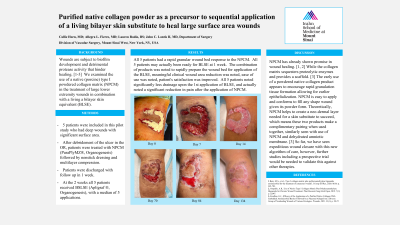Clinical Research
(CR-025) Purified native collagen powder as a precursor to sequential application of a living bilayer skin substitute to heal large surface area wounds
Friday, April 28, 2023
7:15 PM - 8:30 PM East Coast USA Time

Lauren Rodio, BS; John Lantis, MD
Introduction: Wounds are subject to biofilm development and detrimental protease activity that hinder healing [1-3]. We examined the use of a native (porcine) type I powdered collagen matrix (NPCM) in the treatment of large lower extremity wounds in combination with a living a bilayer skin equivalent (BLSE).
Methods: 5 patients were included in this pilot study who had deep wounds with significant surface area. Immediately after debridement of the ulcer in the operating room, these patients were treated with NPCM (PuraPlyMZ®, Organogenesis) followed by nonstick dressing and multilayer compression. Patients were discharged with follow up in 1 week. At the 2 week mark all 5 patients received BSLSE (Apligraf ®, Organogenesis), with a median of 5 applications.
Results: All 5 patients had a rapid granular wound bed response to the NPCM. All 5 patients may actually been ready for BLSE at 1 week. The combination of products was noted to rapidly prepare the wound bed for application of the BLSE, meaningful clinical wound area reduction was noted, ease of use was noted, patient's satisfaction was improved. All 5 patients noted significantly less drainage upon the 1st application of BLSE, and actually noted a significant reduction in pain after the application of NPCM.
Discussion: NPCM has already shown promise in wound healing.[1, 2] While the collagen matrix sequesters proteolytic enzymes and provides a scaffold.[3] The early use of a powdered native collagen product appears to encourage rapid granulation tissue formation allowing for earlier epithelialization. NPCM is easy to apply and conforms to fill any shape wound given its powder form. Theoretically, NPCM helps to create a neo-dermal layer needed for a skin substitute to succeed, which means these two products make a complimentary pairing when used together, similarly seen with use of NPCM and dehydrated amniotic membrane.[3] So far, we have seen expeditious wound closure with this new algorithm of care, however, further studies including a prospective trial would be needed to validate this against other therapies.
Methods: 5 patients were included in this pilot study who had deep wounds with significant surface area. Immediately after debridement of the ulcer in the operating room, these patients were treated with NPCM (PuraPlyMZ®, Organogenesis) followed by nonstick dressing and multilayer compression. Patients were discharged with follow up in 1 week. At the 2 week mark all 5 patients received BSLSE (Apligraf ®, Organogenesis), with a median of 5 applications.
Results: All 5 patients had a rapid granular wound bed response to the NPCM. All 5 patients may actually been ready for BLSE at 1 week. The combination of products was noted to rapidly prepare the wound bed for application of the BLSE, meaningful clinical wound area reduction was noted, ease of use was noted, patient's satisfaction was improved. All 5 patients noted significantly less drainage upon the 1st application of BLSE, and actually noted a significant reduction in pain after the application of NPCM.
Discussion: NPCM has already shown promise in wound healing.[1, 2] While the collagen matrix sequesters proteolytic enzymes and provides a scaffold.[3] The early use of a powdered native collagen product appears to encourage rapid granulation tissue formation allowing for earlier epithelialization. NPCM is easy to apply and conforms to fill any shape wound given its powder form. Theoretically, NPCM helps to create a neo-dermal layer needed for a skin substitute to succeed, which means these two products make a complimentary pairing when used together, similarly seen with use of NPCM and dehydrated amniotic membrane.[3] So far, we have seen expeditious wound closure with this new algorithm of care, however, further studies including a prospective trial would be needed to validate this against other therapies.

.png)